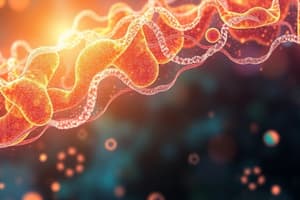Podcast
Questions and Answers
What does a negative value of ΔG indicate about a reaction?
What does a negative value of ΔG indicate about a reaction?
- The reaction is at equilibrium.
- The reaction requires heat to proceed.
- The reaction absorbs energy.
- The reaction is spontaneous and releases energy. (exergonic) (correct)
What does the variable T in the Gibbs equation represent?
What does the variable T in the Gibbs equation represent?
- Total energy of the system
- Thermal capacity of the system
- Time duration of the reaction
- Temperature in Kelvin (correct)
Which of the following statements about endergonic reactions is true?
Which of the following statements about endergonic reactions is true?
- They release energy into the surrounding environment.
- They are characterized by a positive value of ΔG. (correct)
- They occur spontaneously without energy input.
- They result in a negative value of ΔG.
If ΔH is greater than TΔS in the Gibbs equation, what can be inferred about ΔG?
If ΔH is greater than TΔS in the Gibbs equation, what can be inferred about ΔG?
In the context of the Gibbs equation, what does the term ΔS represent?
In the context of the Gibbs equation, what does the term ΔS represent?
What characterizes an exothermic reaction?
What characterizes an exothermic reaction?
Which statement is true regarding the heat content of reactants and products in an endothermic reaction?
Which statement is true regarding the heat content of reactants and products in an endothermic reaction?
What is the consequence of a negative enthalpy change (ΔH) in a reaction?
What is the consequence of a negative enthalpy change (ΔH) in a reaction?
In the Gibbs free energy equation, what influence does increasing temperature (T) have on ΔG when ΔH is positive?
In the Gibbs free energy equation, what influence does increasing temperature (T) have on ΔG when ΔH is positive?
How is the standard enthalpy change (ΔH) characterized for a reaction that releases heat?
How is the standard enthalpy change (ΔH) characterized for a reaction that releases heat?
What does an increase in entropy (+ve value) indicate about a system?
What does an increase in entropy (+ve value) indicate about a system?
How is the absolute temperature of 25 degrees Celsius expressed in Kelvin?
How is the absolute temperature of 25 degrees Celsius expressed in Kelvin?
Which statement best describes the relationship between products and reactants concerning entropy?
Which statement best describes the relationship between products and reactants concerning entropy?
What happens when there is a loss of entropy in a system?
What happens when there is a loss of entropy in a system?
If a substance experiences an increase in disorder, what is the expected change in its entropy value?
If a substance experiences an increase in disorder, what is the expected change in its entropy value?
What is the primary reason gases drive reactions forward compared to solids and liquids?
What is the primary reason gases drive reactions forward compared to solids and liquids?
Which of the following statements best explains enthalpic contributions to chemical processes?
Which of the following statements best explains enthalpic contributions to chemical processes?
How does increasing disorder among reactants and products relate to chemical reactions?
How does increasing disorder among reactants and products relate to chemical reactions?
Which of the following best describes the impact of forming gaseous products in a reaction?
Which of the following best describes the impact of forming gaseous products in a reaction?
What role does entropy play in the favorability of processes involving gas products?
What role does entropy play in the favorability of processes involving gas products?
How do living systems create order from disorder despite the second law of thermodynamics?
How do living systems create order from disorder despite the second law of thermodynamics?
What role do neurons play in maintaining order within living systems?
What role do neurons play in maintaining order within living systems?
What process do cells primarily use to organize amino acids and nucleic acids?
What process do cells primarily use to organize amino acids and nucleic acids?
Which statement best describes the organization of cells compared to the principles of diffusion?
Which statement best describes the organization of cells compared to the principles of diffusion?
How do living systems challenge traditional interpretations of the second law of thermodynamics?
How do living systems challenge traditional interpretations of the second law of thermodynamics?
Which statement best summarizes the relationship between an organism's entropy and overall system entropy?
Which statement best summarizes the relationship between an organism's entropy and overall system entropy?
What is the consequence of an organism decreasing its entropy?
What is the consequence of an organism decreasing its entropy?
Considering the second law of thermodynamics, which scenario illustrates an organism's entropy change?
Considering the second law of thermodynamics, which scenario illustrates an organism's entropy change?
Which of the following principles is violated when an organism decreases its entropy without increasing the total entropy of the system?
Which of the following principles is violated when an organism decreases its entropy without increasing the total entropy of the system?
What does Kleiber's Law indicate about the metabolic rate of an animal when its size is doubled?
What does Kleiber's Law indicate about the metabolic rate of an animal when its size is doubled?
According to Kleiber's Law, what is the exponent indicating the relationship between mass and metabolic rate?
According to Kleiber's Law, what is the exponent indicating the relationship between mass and metabolic rate?
What is the implication of the slope of ¾ determined by Kleiber's Law?
What is the implication of the slope of ¾ determined by Kleiber's Law?
If an animal's size increases but remains less than double, what can be inferred about its metabolic rate in relation to Kleiber's Law?
If an animal's size increases but remains less than double, what can be inferred about its metabolic rate in relation to Kleiber's Law?
What does the empirical determination of the slope ¾ in Kleiber's Law suggest about larger animals?
What does the empirical determination of the slope ¾ in Kleiber's Law suggest about larger animals?
Flashcards are hidden until you start studying
Study Notes
Gibbs Equation
- The Gibbs Free Energy (ΔG) equation is expressed as ΔG = ΔH - TΔS.
- ΔH represents the change in enthalpy, indicating heat content during a reaction.
- T is the absolute temperature measured in Kelvin.
- ΔS denotes the change in entropy, reflecting the disorder or randomness of a system.
Gibbs Free Energy Definition
- ΔG signifies the amount of energy available to perform work during a reaction while maintaining constant temperature and pressure.
- Negative ΔG values indicate exergonic reactions, where the system loses energy and tends to occur spontaneously.
- Positive ΔG values signify endergonic reactions, where the system gains energy, indicating non-spontaneous processes.
Gibbs Free Energy Equation
- The formula for Gibbs Free Energy is ΔG = ΔH - TΔS, where ΔG represents change in free energy, ΔH represents change in enthalpy, T is temperature in Kelvin, and ΔS is change in entropy.
Enthalpy
- Enthalpy (H) refers to the total heat content of a reacting system, influenced by the chemical bonds of both reactants and products.
Exothermic Reactions
- Exothermic reactions release heat into the surroundings.
- In these reactions, the heat content of the products is lower than that of the reactants.
- By convention, exothermic reactions are assigned a negative value for ΔH.
Endothermic Reactions
- Endothermic reactions absorb heat from the surroundings.
- In these cases, the heat content of the products is higher compared to that of the reactants.
- Endothermic reactions are assigned a positive value for ΔH.
Entropy (S)
- Entropy represents the level of disorder within a system.
- Products of a reaction exhibit greater disorder and lower complexity compared to the reactants.
Change in Entropy
- An increase in disorder correlates with a gain in entropy, resulting in a positive entropy change (+ve value).
- A decrease in disorder signifies a loss of entropy, producing a negative entropy change (-ve value).
Temperature (T)
- Temperature is measured in absolute terms, specifically in degrees Kelvin (K).
- Standard conversion: 25 degrees Celsius is equivalent to 298 Kelvin.
Favorable Processes
- Processes can be driven by enthalpic factors, where heat is released (exothermic reactions).
- They can also be driven by entropic factors, favoring formation of more disordered products compared to reactants.
Entropy and Phases of Matter
- Gases exhibit higher entropy than liquids and solids due to their increased disorder and freedom of movement.
- Reactions that produce gases, such as CO2 formation, can significantly enhance the overall entropy of the system, thereby driving the reaction forward.
Spontaneous Processes in Living Systems
- Living systems operate through a series of spontaneous processes that seemingly contradict the second law of thermodynamics, which states that entropy tends to increase in isolated systems.
- Despite the natural inclination towards disorder, living organisms create order from disorder by actively organizing their internal environments.
Cellular Organization
- Cells maintain order by systematically organizing electrolytes and molecules across membranes, counteracting the natural process of diffusion.
- This organizational capacity allows cells to sustain complex internal structures necessary for life functions.
Neuronal Activity
- Neurons utilize the movement of electrolytes, particularly during action potentials, to transmit nerve impulses efficiently.
- The generation of action potentials results in a sequential induction of other action potentials, reflecting a highly ordered neurological control system.
Molecular Construction
- Cells incorporate amino acids and nucleic acids into specific structures, forming tightly constrained proteins, DNA, and RNA.
- This meticulous arrangement illustrates the ability of living systems to create complex macromolecules essential for genetic information and cellular functions.
Gibbs Equation and Free Energy
- Gibbs free energy (ΔG) is calculated using the equation ΔG = ΔH - TΔS.
- ΔG represents the energy available to perform work in a reaction at constant temperature and pressure.
- A negative ΔG indicates an exergonic reaction, where the system loses energy, favoring spontaneity.
- A positive ΔG signifies an endergonic reaction, where the system gains energy, requiring external input.
Enthalpy (ΔH)
- Enthalpy (H) is the heat content of a reacting system, influenced by the chemical bonds in reactants and products.
- In exothermic reactions, heat is released; the heat content of products is lower than that of reactants, resulting in a negative ΔH value.
- Endothermic reactions absorb heat; the heat content of products is greater than that of reactants, leading to a positive ΔH value.
Entropy (ΔS)
- Entropy (S) measures the disorder of a system.
- For reactions, products are often less complex and more disordered than reactants, resulting in a positive ΔS value when disorder increases.
- Decreasing disorder results in negative entropy, indicating a loss of entropy.
Temperature (T)
- The absolute temperature (T) is measured in Kelvin (K); 25°C is equivalent to 298K.
- Temperature influences both enthalpic and entropic contributions to ΔG.
Favorability of Processes
- Reactions may be favorable for enthalpic reasons (heat release) or entropic reasons (increased disorder of products).
- Gases have higher entropy than liquids or solids, thus reactions producing gases (e.g., CO2) can drive reactions forward.
Living Systems and Entropy
- Living systems appear to contravene the second law of thermodynamics by creating order from disorder.
- Cellular processes organize molecules and electrolytes across membranes against diffusion principles.
- Neuronal action potentials utilize electrolyte movements to generate nerve impulses in ordered patterns.
- Cells synthesize amino acids and nucleic acids into structured proteins, DNA, and RNA, effectively reducing their own entropy at the expense of increasing the total entropy of the system.
Metabolic Energy and Size
- Larger life forms require increased metabolic energy to sustain their physiological functions.
- Kleiber’s Law explains the relationship between metabolic rate and body mass, asserting that metabolic rate is proportional to mass raised to the power of 3/4.
Implications of Kleiber’s Law
- When an animal's size is doubled, its metabolic rate increases by a factor of approximately 1.68, illustrating a non-linear relationship.
- The empirical determination of the slope (¾) highlights the significance of scaling effects in biology and ecology.
- Understanding these relationships is crucial for studying energy consumption, growth patterns, and ecological dynamics in various species.
Studying That Suits You
Use AI to generate personalized quizzes and flashcards to suit your learning preferences.




